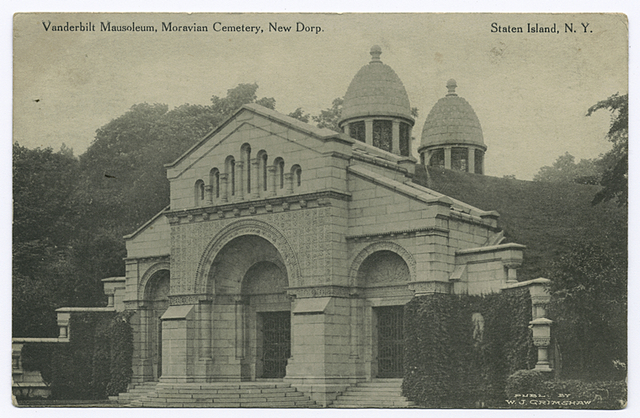 Vanderbilt Mausoleum | via Wikipedia
Vanderbilt Mausoleum | via Wikipedia
Cornelius Vanderbilt, the man who would grow up to become the wealthiest man in America, was born on May 27, 1794 in Port Richmond, the fourth of nine children. His parents, Cornelius van Derbilt and Phebe Hand, family emigrated from the Netherlands. One story says that Cornelius started on the road to riches by borrowing $100 from his parents to buy a sailing barge. With that one boat, he started ferrying people and freight between Staten Island and Manhattan, the humble beginnings of what would become a thriving steamboat business. In 1838, he took over the Staten Island Ferry, the iconic ferry service that still operates today.
Steamboats would lead to ocean-going steamships, and eventually a railroad empire that made Vanderbilt, in today’s dollars, one of the three richest Americans of all time. Fortunately for Staten Island, he never forgot his roots. Cornelius Vanderbilt donated land to the Moravian Church (a Protestant Denomination) and cemetery. The property, located in the New Dorp section of Staten Island, was later expanded upon by Vanderbilt’s son. Moravian Cemetery, which was founded in 1740, is famous for housing the remains of the Vanderbilts. The Vanderbilt mausoleum was designed by Richard Morris Hunt between 1885 and 1886, and was landscaped by Frederick Law Olmstead. It is modeled on a Romanesque church in Arles, France, and is three stories tall. The cemetery offers tours; however, the Vanderbilt section is not open to the public.
 One of the first Vanderbilt family mausoleums | via Facebook
One of the first Vanderbilt family mausoleums | via Facebook
The mausoleum holds the remains of “Commodore” Cornelius Vanderbilt and seven of his relatives. The gated section of the cemetery is considered to be haunted and is associated with many tragedies and accidents. According to local lore, a woman was once killed trying to break into the Vanderbilt section; the gate is said to have fallen on her, killing her instantly. Additionally, people have reported seeing strange lights and apparitions in the shape of a woman, possibly the aforementioned woman, and a man in a gray suit, said to be Cornelius Vanderbilt himself.
Aside from the potentially haunted Vanderbilt Mausoleum, more locations around Staten Island are named after the famous magnate. P.S. 014 Cornelius Vanderbilt and Vanderbilt Avenue carry on his name. His legacy still lives on, in the form of the Staten Island Ferry, the business venture that once made him the wealthiest man in the United States.

